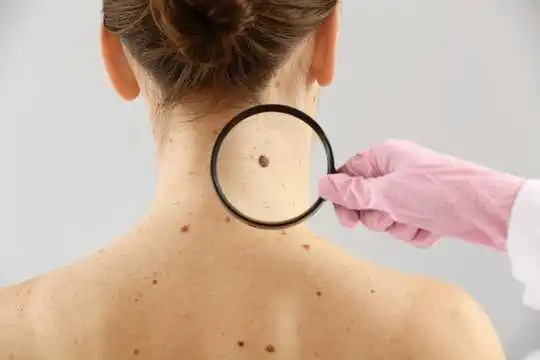Melanoma skin cancer is the fifth most common cancer – with 16,000 cases diagnosed and 2,400 deaths every year in the UK. Over the last decade, diagnoses have increased by almost half – with a more considerable rise in males (55%) than in females (35%). Yet, this is not the only difference between men and women when it comes to melanoma.
Men, it seems, are much more likely to develop melanoma on the head, neck and trunk, and women on the legs. Prognosis also seems to differ between the sexes, with female patients living for longer after diagnosis than males.
Research shows the total number of moles a person has on their body is a powerful predictor of their general melanoma risk. So the more moles you have, the higher your chance of developing melanoma.
We also know from previous research that there is a difference in the number of moles children have. And that like adults, boys have more moles on the head, neck and trunk, and girls on the legs. But whether these differences are down to sun exposure or genetics is under debate.
Get The Latest By Email
Indeed, research shows that children living in the sunniest climates have more moles. But differences in the number of moles cannot be explained by sun exposure alone. Indeed, research has found that boys and girls who live in the same climate – with similar sun exposure on their legs – still have a different number of moles.
Given this, in our latest study, we wanted to look at whether these sex differences also persist into adulthood. Our team from King’s College London analysed a large group of 3,200 healthy twins, predominately female, and counted moles on their head and neck, back, abdomen and chest, upper limbs and lower limbs. And we found that, indeed, women have, on average, twice the number of moles on the legs compared to men.
We also investigated the link between genes and number of moles in different areas of the body. We discovered that for the women in our study, 70% of the moles on their legs could be explained by genetics – while the remaining 30% were down to environmental factors, such as sun exposure. For comparison, on the trunk – a site less common for melanoma in women – we found genetics to be only responsible for 26% of the moles.
Gender differences
Previous studies have highlighted the fact that genes responsible for the growth of moles also influence melanoma development. So we also tested whether these genes had differing effects on the growth of moles in different areas of the body.
We discovered that most of these genes influenced the number of moles on the legs, while only one of the genes influenced the number of moles on the trunk. So it seems that in women, the area of the body where both melanoma and moles are more common – the legs – is also the place where genes play the most substantial role in terms of mole growth. This confirms genetics plays a part in not only the number of moles a person has but also where they are on the body.
 Not only the number but also the location of moles on the body is in large part due to genetics. Pixel-Shot/Shutterstock
Not only the number but also the location of moles on the body is in large part due to genetics. Pixel-Shot/Shutterstock
The scientific and medical community has just started to acknowledge that sex differences between men and women should be taken into account when studying and treating diseases. And our results underline the importance of this approach in preventing and treating melanoma skin cancer.
Further studies now need to be done to assess whether our findings are also relevant to men. But in the meantime, keep in mind that the number of moles you have indicates your melanoma risk. And while this is mainly under genetic control, sun exposure does increase your mole and cancer risk – so it’s important to keep wearing a hat and sunblock when out in the sun.![]()
About The Author
Alessia Visconti, Research fellow, King's College London
This article is republished from The Conversation under a Creative Commons license. Read the original article.
books_health








